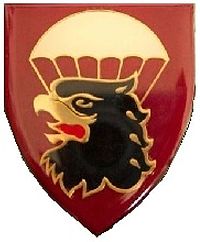44 Parachute Regiment
| 44 Parachute Regiment | |
|---|---|

44 Para Regiment emblem
|
|
| Active | 2000 - present(as regiment) |
| Country |
|
| Branch |
|
| Type | Airborne |
| Role | Light infantry |
| Size | 3 Battalions |
| Garrison/HQ | Tempe, Bloemfontein |
| Beret Colour | Maroon |
| Engagements | |
| Commanders | |
| Notable commanders |
|
44 Parachute Regiment is the South African Army's chief airborne infantry unit. It was created in 2000 by redesignating 44 Parachute Brigade, and is based at the Tempe military base near Bloemfontein.
The first South African airborne unit was formed in August 1943, when a Parachute Platoon of the South African Air Force was established. However, this unit was disbanded before training could be completed.
There were no further attempts to establish any airborne units until 1961, when selected members of the South African Army received parachute training at RAF Abingdon. This was followed by the establishment of 1 Parachute Battalion under Commandant Willem Louw on 1 April 1961.
On 26 August 1966, units of 1 Parachute Battalion (called Parabats) first participated in operations as part of the South African Border War in South-West Africa (now Namibia). This involvement was eventually to last for more than twenty years.
In April 1978 44 Parachute Brigade was established, with the addition of 2 and 3 Parachute Battalions.
On 4 May 1978 South Africa's first major airborne operation (Operation Reindeer) took place. A large group of paratroopers, from 1,2 and 3 Battalions, attacked a large SWAPO base in Angola, successfully capturing it. (See Battle of Cassinga).
Following the end of the Border War in 1989, the Brigade was scaled down slightly and began preparing for a new role, that of conducting operations internally in South Africa in order to quell increasing levels of violence between various political groups.
In January 1991 the Brigade conducted its first operational jump in an urban counterinsurgency role when 2 Parachute Battalion deployed to Natal as part of Operation Eardrum to quell the violence. The Brigade took part in many similar operations in the following years, helping to minimise the violence sufficiently to allow South Africa's first democratic elections to go ahead in April 1994.
...
Wikipedia
